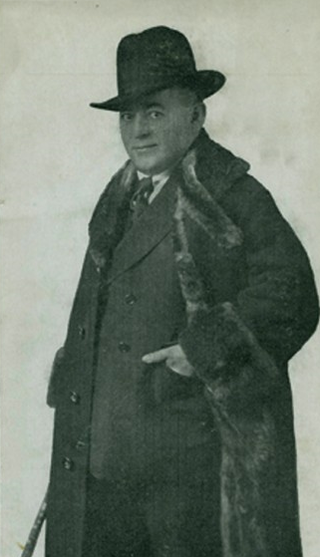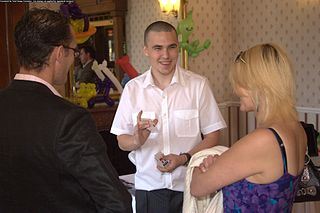Sleight of hand refers to fine motor skills when used by performing artists in different art forms to entertain or manipulate. It is closely associated with close-up magic, card magic, card flourishing and stealing. Because of its heavy use and practice by magicians, sleight of hand is often confused as a branch of magic; however, it is a separate genre of entertainment and many artists practice sleight of hand as an independent skill. Sleight of hand pioneers with worldwide acclaim include Dan and Dave, Ricky Jay, Derek DelGaudio, David Copperfield, Yann Frisch, Norbert Ferré, Dai Vernon, Cardini, Tony Slydini, Helder Guimarães and Tom Mullica.

Card manipulation is the branch of magic that deals with creating effects using sleight of hand techniques involving playing cards. Card manipulation is often used in magical performances, especially in close-up, parlor, and street magic. Some of the most recognized names in this field include Dai Vernon, Tony Slydini, Ed Marlo, S.W. Erdnase, Richard Turner, John Scarne, Ricky Jay and René Lavand. Before becoming world-famous for his escapes, Houdini billed himself as "The King of Cards". Among the more well-known card tricks relying on card manipulation are Ambitious Card, and Three-card Monte, a common street hustle also known as Find the Lady.

Coin magic is the manipulating of coins to entertain audiences. Because coins are small, most coin tricks are considered close-up magic or table magic, as the audience must be close to the performer to see the effects. Though stage conjurers generally do not use coin effects, coin magic is sometimes performed onstage using large coins. In a different type of performance setting, a close-up coin magician will use a large video projector so the audience can see the magic on a big screen. Coin magic is generally considered harder to master than other close-up techniques such as card magic, as it requires great skill and grace to perform convincingly, and this requires much practice to acquire.
A trick deck is a deck of playing cards that has been altered in some way to allow magicians to perform certain card tricks where sleight of hand would be too difficult or impractical.
The Ambitious Card, or Elevator Card, is a magic effect in which a playing card seems to return to the top of the deck after being placed elsewhere in the middle of the deck. This is a classic effect in card magic and serves as a study subject for students of magic. Most performing card magicians will have developed their own personal Ambitious Card routine.

David Frederick Wingfield Verner, better known by his stage names Dai Vernon or The Professor, was a Canadian magician.

Max Malini was a magician who at his peak performed for several US Presidents and at Buckingham Palace, receiving gifts from monarchs across Europe and Asia. Many magicians, such as Dai Vernon and Ricky Jay, have held him in high esteem for his skill and bold accomplishments.
A double lift is a sleight of hand maneuver used by magicians in card magic. It is a method by which the identity of the top card may be kept secret by lifting the top two cards as one, making it seem as if only the top card is picked up. Similar techniques may be applied to more than two cards to perform a triple or even quadruple lift. The term was coined by Theo Annemann.

John Carney is a professional sleight-of-hand artist, author and comic actor. He won various awards from the Academy of Magical Arts, including "stage magician of the year", "close-up magician of the year", and "parlour magician of the year". In 1988 and 1991, he won first and second place, respectively, in "micro magic" at the world Fédération Internationale des Sociétés Magiques championships. Carney studied under sleight of hand magician Dai Vernon.
This timeline of magic is a history of the performing art of illusion from B.C. to the present.
Howard Schwarzman was an American magician, card manipulator, sleight of hand expert, and trick inventor. Considered a "living legend" in the Eastern United States magician community, he was best known as a columnist within the magician trade press, and an importer of very rare tricks from outside the United States.

The Expert at the Card Table, is an extensive book on the art of sleight of hand published in 1902 by S. W. Erdnase, a pseudonymous author whose identity has remained a mystery for over a century. As a detailed manual of card sharps, the book is considered to be one of the most influential works on magic or conjuring with cards.

Close-up magic is magic performed in an intimate setting usually no more than 3 meters from one's audience and is usually performed while sitting at a table.

Al Baker was a professional magician. Al Baker was an inventor of many tricks that he marketed including his Dictionary Test, Al Baker Slates and his version of the Rice bowls. Many of his silk magic effects were included in Rice's Encyclopedia of Silk Magic. Al Baker opened a magic shop with Martin Sunshine in Times Square. Al Baker also regularly contributed to The Sphinx and other magic magazines.

Lewis Jack Ganson was an English magician who became one of the most prolific writers in magic, going on to write and edit more than sixty books on the subject.

The Magic Castle is a clubhouse for the Academy of Magical Arts and for magicians and magic enthusiasts. It is in the Hollywood district of Los Angeles, California, and it bills itself as "the most unusual private club in the world."
Walter Irving Scott was an American musician, cardsharp and amateur magician. His glowing reputation among magicians and card men revolves around his time as a card cheat and a single demonstration of sleight-of-hand to some of the era's best magicians in New York in 1930. He lived out his last years in Rhode Island as a music teacher. Scott spent his formative years perfecting several difficult sleights of card manipulation in order to work as a cardsharp in card games throughout America. He participated in several different types of swindles and hustles. Eventually turning to a music career he was asked to perform one more demonstration. This single event created a legend within the magic community that continues to this day.

The art form of card flourishing, commonly referred to as cardistry, grew out of simple flourishes used in close-up magic by magicians in the 1990s to early 2000s. Chris Kenner's notable two-handed Sybil cut from his 1992 publication Totally Out of Control has carried great influence and gave birth to a series of advanced flourishes which today represents the foundation of the performance art. Sleight of hand pioneers Dan and Dave Buck popularized cardistry on the world stage with their instructional DVD releases from 2004 and 2007. Journalist Kevin Pang of Vanity Fair characterized the art of card flourishing as, "It's yo-yo tricks performed by cardsharps with the street cred of a Parkour video. There's a name for it: cardistry."
Nate Leipzig was an American vaudeville magician who performed in Europe and the United States. In May 1938, Leipzig was elected president of the SAM. Previous presidents of SAM include Howard Thurston and Harry Houdini. His innovations of sleight of hand, particularly with card tricks and close-up magic, garnered him respect among fellow magicians. Leipzig was the first magician to perform a stage act using playing cards and thimbles, and is credited with inventing the Side Steal—a technique for secretly removing a playing card from the middle of a deck of cards.

Bruce Cervon was an American magician who was best known for his close-up magic, both through performance and invention. He published a series of books and helped to create a permanent record of the magic of Dai Vernon through The Vernon Chronicles, Dai Vernon's Ultimate Secrets of Card Magic, and Bruce Cervon's Castle Notebooks.












